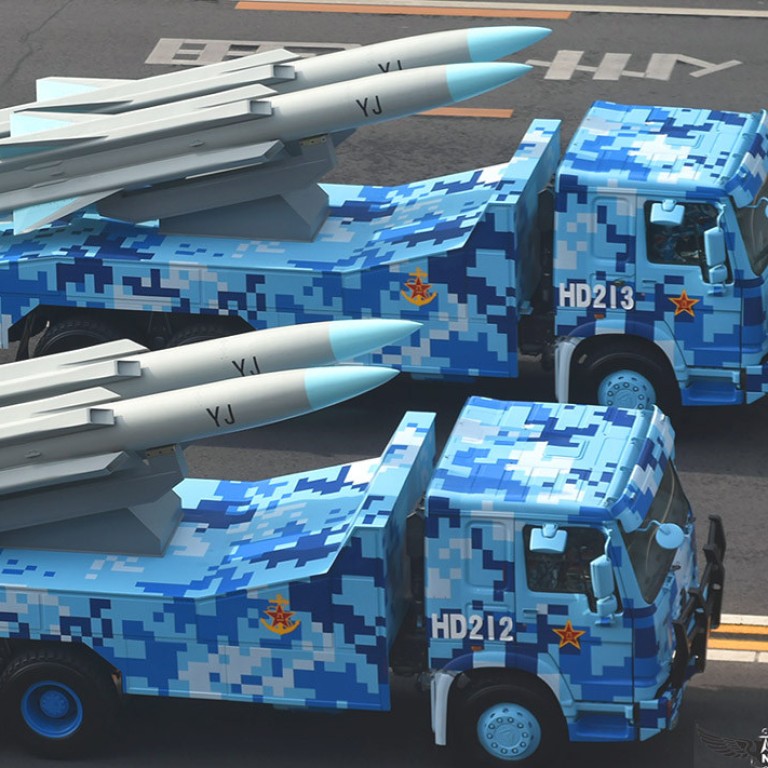
Taiwan needs strategy to deal with PLA’s YJ-12 missile, island’s military says
- Seen as mainland China’s most dangerous anti-ship missile, the YJ-12 is a threat to Taiwan and has advantages over US ships’ air-defence systems, according to article
- With its warships unable to repel the missile, the island must ‘come up with innovative and asymmetric strategies’, active naval commanders write
Claimed to be Beijing’s most dangerous anti-ship missile because of its range and speed, the YJ-12 can be launched from land, air and sea, and has advantages over the ship-borne air-defence systems on American aircraft carriers, according to an article in December’s edition of the Taiwanese military’s bimonthly Navy Professional journal.
“The Taiwan Strait is no longer a natural barrier to deter a growing and powerful PLA from across the waterway, and none of the Taiwan warships is able to deal with the powerful YJ-12,” the article said.
“In such a military disparity, the Taiwanese military has to carefully assess its position and try to come up with innovative and asymmetric strategies to hit the enemy’s weakness.”
“The YJ-12 is a mixture of Russian and Chinese supersonic missile technologies,” it said, explaining that it was based on the Soviet P-270 Moskit supersonic anti-ship cruise missile, supported by the PLA’s advanced guiding radars and home-built BeiDou global navigation system to boost its precision strike capability.
It said the detection range of the antenna array on the American navy’s early-warning aircraft was about 320km (200 miles), but the YJ-12 missile had an operation range of over 400km.
It also said that it was almost impossible to intercept a YJ-12 warhead, which has a speed of Mach four and can reach a target within 30 seconds once fired.
Satellite images have shown that the YJ-12 has been deployed to Fiery Cross, Mischief and Subi reefs – three artificial islands built by the PLA in the South China Sea – to deter US and Japanese vessels from coming to Taiwan’s aid if it were attacked by the PLA, the article said.
Beijing regards self-ruled Taiwan as a renegade province to be returned to the mainland, by force if necessary.
The PLA expects the US and Japan to become involved in air and at sea in the event of a Taiwan contingency, and the YJ-12 – designed to target large and medium-sized vessels – could be used mainly against them, according to former PLA missile force instructor Song Zhongping.
“The deployment of YJ-12 missiles is aimed at warning the US and Japanese militaries that they could pay a huge price if they decided to intervene in the Taiwan issue,” Song said.
The mainland military has 2 million troops equipped with two aircraft carrier platforms, about 780 warships and more than 3,000 military aircraft, compared with Taiwan’s 183,000 military personnel, about 120 naval ships and more than 700 fighter jets.
Taiwan has developed its own coastal defence hypersonic cruise missile, the Hsiung Feng III, and the authors suggested deploying it on the front line along with the more powerful American harpoon missile that Washington has agreed to sell to the island.
The Taiwanese government said in 2020 that the harpoon missile would have a range of 125km and would be an asymmetric weapon capable of repelling many of the PLA’s warships in the event of an invasion.
What are rival claimants building on South China Sea islands and reefs?
Another article, by Peng Chih-ling, an active ground force lieutenant colonel, detailed some counter-strategies that Taiwan could develop.
These included reinforcing defences along shores targeted by the PLA as landing sites, stepping up the island’s submarine development, deploying a grid of missiles and drones with precision strike capability to target warships, and further improving ties with Japan and other regional countries as well as the US.


